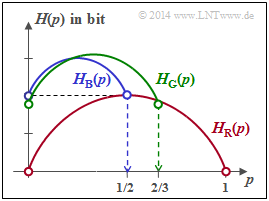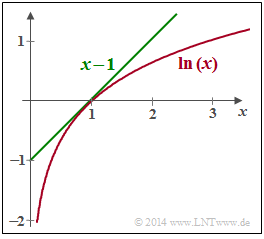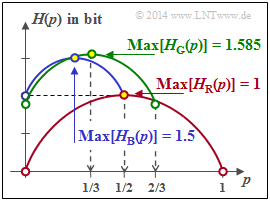Difference between revisions of "Aufgaben:Exercise 3.3: Entropy of Ternary Quantities"
From LNTwww
m (Textersetzung - „*Sollte die Eingabe des Zahlenwertes „0” erforderlich sein, so geben Sie bitte „0.” ein.“ durch „ “) |
|||
| (16 intermediate revisions by 3 users not shown) | |||
| Line 1: | Line 1: | ||
| − | {{quiz-Header|Buchseite= | + | {{quiz-Header|Buchseite=Information_Theory/Some_Preliminary_Remarks_on_Two-Dimensional_Random_Variables |
}} | }} | ||
| − | [[File:P_ID2754__Inf_A_3_3.png|right| | + | [[File:P_ID2754__Inf_A_3_3.png|right|frame|Given entropy functions]] |
| − | + | On the right you see the entropy functions $H_{\rm R}(p)$, $H_{\rm B}(p)$ and $H_{\rm G}(p)$, where $\rm R$ stands for "red", $\rm B$ for "blue" and $\rm G$ for "green". The probability functions are for all random variables: | |
| − | :$$P_X(X) = [\hspace{0.05cm}p_1\hspace{0.05cm}, p_2\hspace{0.05cm}, p_3\hspace{0.05cm}]\hspace{0.3cm}\hspace{0.3cm} \Rightarrow \hspace{0.3cm} |X| = 3\hspace{0.05cm}.$$ | + | :$$P_X(X) = [\hspace{0.05cm}p_1\hspace{0.05cm},\ p_2\hspace{0.05cm},\ p_3\hspace{0.05cm}]\hspace{0.3cm}\hspace{0.3cm} \Rightarrow \hspace{0.3cm} |X| = 3\hspace{0.05cm}.$$ |
| − | + | For the questionnaire, the relationship $p_1 = p$ and $p_2 = 1 - p_3- p$. | |
| − | + | The probability function of a random variable | |
| − | :$$X = \{\hspace{0.05cm}x_1\hspace{0.05cm}, \hspace{0. | + | :$$X = \big \{\hspace{0.05cm}x_1\hspace{0.05cm}, \hspace{0.15cm} x_2\hspace{0.05cm},\hspace{0.15cm} \text{...}\hspace{0.1cm} ,\hspace{0.15cm} x_{\mu}\hspace{0.05cm}, \hspace{0.05cm}\text{...}\hspace{0.1cm} , \hspace{0.15cm} x_{M}\hspace{0.05cm}\big \}$$ |
| − | + | with the symbolic range $|X| = M$ is generally: | |
| − | :$$P_X(X) = [\hspace{0.05cm}p_1\hspace{0.05cm}, \hspace{0. | + | :$$P_X(X) = [\hspace{0.05cm}p_1\hspace{0.05cm}, \hspace{0.15cm} p_2\hspace{0.05cm},\hspace{0.05cm} ...\hspace{0.1cm} ,\hspace{0.15cm} p_{\mu}\hspace{0.05cm}, \hspace{0.05cm}...\hspace{0.1cm} , \hspace{0.15cm} p_{M}\hspace{0.05cm}]\hspace{0.05cm}.$$ |
| − | + | The entropy (uncertainty) of this random variable is calculated according to the equation | |
| − | :$$H(X) = {\rm E} \ | + | :$$H(X) = {\rm E} \big [\log_2 \hspace{0.05cm} {1}/{P_X(X)} \big ]\hspace{0.05cm},$$ |
| − | + | and always lies in the range $0 \le H(X) \le \log_2 \hspace{0.05cm} |X|$. | |
| − | + | *The lower bound $H(X) = 0$ results when any probability $p_\mu = 1$ and all others are zero. | |
| − | |||
| − | |||
| − | |||
| − | |||
| − | |||
| − | |||
| − | |||
| − | + | *The upper bound is to be derived here as in the lecture "Information Theory" by [[Biographies_and_Bibliographies/Lehrstuhlinhaber_des_LNT#Prof._Dr._sc._techn._Gerhard_Kramer_.28seit_2010.29|Gerhard Kramer]] at the TU Munich: | |
| − | * | + | [[File:P_ID2755__Inf_A_3_3_B_neu.png|right|frame|Upper bound estimate for the natural logarithm]] |
| − | * | + | :* By extending the above equation by $|X|$ in the numerator and denominator, using $\log_2 \hspace{0.05cm}x= \ln(x)/\ln(2)$, we obtain: |
| − | * | + | ::$$H(X) = \frac{1}{{\rm ln}(2)}\cdot {\rm E} \left [{\rm ln} \hspace{0.1cm} \frac{1}{|X| \cdot P_X(X)} \right ] + {\rm log}_2 \hspace{0.1cm}|X| \hspace{0.05cm}.$$ |
| + | :* As can be seen from the graph opposite, the estimation $\ln(x) \le x-1$ holds with the identity for $x=1$. Thus, it can be written: | ||
| + | ::$$H(X) \le \frac{1}{{\rm ln}(2)}\cdot {\rm E} \left [\frac{1}{|X| \cdot P_X(X)} -1 \right ] + {\rm log}_2 \hspace{0.1cm}|X| \hspace{0.05cm}.$$ | ||
| + | :* In [[Aufgaben:3.2_Erwartungswertberechnungen|Exercise 3.2]] the expected value ${\rm E} \big [\log_2 \hspace{0.05cm} {1}/{P_X(X)} \big ] =|X|$ was calculated for the case $p_\mu \ne 0$ for all $\mu$ . Thus, the first term disappears and the known result is obtained: | ||
| + | ::$$H(X) \le {\rm log}_2 \hspace{0.1cm}|X| \hspace{0.05cm}.$$ | ||
| + | |||
| + | |||
| + | |||
| + | |||
| + | |||
| + | |||
| + | Hints: | ||
| + | *The exercise belongs to the chapter [[Information_Theory/Einige_Vorbemerkungen_zu_zweidimensionalen_Zufallsgrößen|Some preliminary remarks on 2D random variables]]. | ||
| + | *In particular, reference is made to the page [[Information_Theory/Einige_Vorbemerkungen_zu_zweidimensionalen_Zufallsgrößen#Wahrscheinlichkeitsfunktion_und_Entropie|Probability function and entropy]]. | ||
| + | *The same constellation is assumed here as in [[Aufgaben:Aufgabe_3.2:_Erwartungswertberechnungen|Exercise 3.2]]. | ||
| − | * | + | *The equation of the binary entropy function is: |
:$$H_{\rm bin}(p) = p \cdot {\rm log}_2 \hspace{0.1cm} \frac{1}{p} + | :$$H_{\rm bin}(p) = p \cdot {\rm log}_2 \hspace{0.1cm} \frac{1}{p} + | ||
(1-p) \cdot {\rm log}_2 \hspace{0.1cm} \frac{1}{1-p} \hspace{0.05cm}.$$ | (1-p) \cdot {\rm log}_2 \hspace{0.1cm} \frac{1}{1-p} \hspace{0.05cm}.$$ | ||
| − | === | + | ===Questions=== |
<quiz display=simple> | <quiz display=simple> | ||
| − | { | + | {Which statements are true for the red entropy function $H_{\rm R}(p)$? |
|type="[]"} | |type="[]"} | ||
| − | + $H_{\rm R}(p)$ | + | + $H_{\rm R}(p)$ results, for example, with $p_1 = p$, $p_2 = 1- p$ and $p_3 = 0$. |
| − | + $H_{\rm R}(p)$ | + | + $H_{\rm R}(p)$ is identical to the binary entropy function $H_{\rm bin}(p)$. |
| − | { | + | {What are the properties of the binary entropy function $H_{\rm bin}(p)$ ? |
|type="[]"} | |type="[]"} | ||
| − | + $H_{\rm bin}(p)$ | + | + $H_{\rm bin}(p)$ is concave with respect to the parameter $p$. |
| − | - | + | - $\text {Max } [H_{\rm bin}(p)] = 2$ bit applies. |
| − | { | + | {Which statements are true for the blue entropy function $H_{\rm B}(p)$? |
|type="[]"} | |type="[]"} | ||
| − | + | + | + $H_{\rm B}(p)$ ergibt sich beispielsweise mit $p_1 = p$, $p_2 = 1/2- p$ und $p_3 = 1/2$. |
| − | + Es gilt $H_{\rm B}(p = 0)= 1 | + | + Es gilt $H_{\rm B}(p = 0)= 1$ bit. |
| − | - Es gilt | + | - Es gilt $\text {Max } [H_{\rm B}(p)] = \log_2 \hspace{0.1cm} (3)$ bit. |
| − | { | + | {Which statements are true for the green entropy function $H_{\rm G}(p)$? |
|type="[]"} | |type="[]"} | ||
| − | + $H_{\rm G}(p)$ | + | + $H_{\rm G}(p)$ results, for example, with $p_1 = p$, $p_2 = 2/3- p$ and $p_3 = 1/3$. |
| − | - | + | - $H_{\rm G}(p = 0)= 1$ bit is valid. |
| − | + | + | + $\text {Max } [H_{\rm G}(p)] = \log_2 \hspace{0.1cm} (3)$ bit applies. |
| Line 67: | Line 74: | ||
</quiz> | </quiz> | ||
| − | === | + | ===Solution=== |
{{ML-Kopf}} | {{ML-Kopf}} | ||
| − | '''(1)''' <u> | + | '''(1)''' <u>Both statements are correct:</u> |
| + | *If we set $p_3 = 0$ and formally $p_1 = p$ ⇒ $p_2 = 1- p$, we get the binary entropy function | ||
:$$H_{\rm bin}(p) = p \cdot {\rm log}_2 \hspace{0.1cm} \frac{1}{p} + | :$$H_{\rm bin}(p) = p \cdot {\rm log}_2 \hspace{0.1cm} \frac{1}{p} + | ||
(1-p) \cdot {\rm log}_2 \hspace{0.1cm} \frac{1}{1-p} \hspace{0.05cm}.$$ | (1-p) \cdot {\rm log}_2 \hspace{0.1cm} \frac{1}{1-p} \hspace{0.05cm}.$$ | ||
| − | '''(2)''' | + | |
| − | :$$H_{\rm bin}(p) = \frac{-1}{{\rm ln}(2)} \cdot \ | + | '''(2)''' Only the <u>proposed solution 1</u> is correct: |
| − | (1-p) \cdot {\rm ln}(1-p) \ | + | *One can also put the binary entropy function into the following form because of $\log(x) = \ln(x)/\ln(2)$ : |
| − | * | + | :$$H_{\rm bin}(p) = \frac{-1}{{\rm ln}(2)} \cdot \big [ p \cdot {\rm ln}(p) + |
| − | :$$\frac {{\rm d}H_{\rm bin}(p)}{{\rm d}p} = \frac{-1}{{\rm ln}(2)} \cdot \ | + | (1-p) \cdot {\rm ln}(1-p) \big ] \hspace{0.05cm}.$$ |
| − | {\rm ln}(1-p) - (1-p) \cdot \frac{1}{1-p} \ | + | *The first derivation leads to the result |
| − | \frac{1}{{\rm ln}(2)} \cdot \ | + | :$$\frac {{\rm d}H_{\rm bin}(p)}{{\rm d}p} = \frac{-1}{{\rm ln}(2)} \cdot \big [ {\rm ln}(p) + p \cdot \frac{1}{p} - |
| − | * | + | {\rm ln}(1-p) - (1-p) \cdot \frac{1}{1-p} \big ] = |
| − | * | + | \frac{1}{{\rm ln}(2)} \cdot \big [ {\rm ln}(1-p) - {\rm ln}(p) \big ] = {\rm log}_2 \hspace{0.1cm} \frac{1-p}{p} \hspace{0.05cm}.$$ |
| + | *By setting this derivative to zero, we obtain the abscissa value $p = 0.5$, which leads to the maximum of the entropy function: $H_{\rm bin}(p =0.5) = 1$ bit <br>⇒ the proposed solution 2 is wrong. | ||
| + | *By differentiating again, one obtains for the second derivative | ||
:$$\frac {{\rm d}^2H_{\rm bin}(p)}{{\rm d}p^2} = \frac{1}{{\rm ln}(2)} \cdot \left | :$$\frac {{\rm d}^2H_{\rm bin}(p)}{{\rm d}p^2} = \frac{1}{{\rm ln}(2)} \cdot \left | ||
[ \frac{-1}{1-p} - \frac{1}{p} \right ] = | [ \frac{-1}{1-p} - \frac{1}{p} \right ] = | ||
\frac{-1}{{\rm ln}(2) \cdot p \cdot (1-p)} \hspace{0.05cm}.$$ | \frac{-1}{{\rm ln}(2) \cdot p \cdot (1-p)} \hspace{0.05cm}.$$ | ||
| − | * | + | *This function is negative in the entire definition domain $0 ≤ p ≤ 1$ ⇒ $H_{\rm bin}(p)$ is concave ⇒ the proposed solution 1 is correct. |
| + | |||
| − | [[File:P_ID2756__Inf_A_3_3_ML.png|right| | + | [[File:P_ID2756__Inf_A_3_3_ML.png|right|frame|Three entropy functions with $M = 3$]] |
| − | '''(3)''' | + | '''(3)''' <u>Propositions 1 and 2</u> are correct here: |
| − | * | + | * For $p = 0$ one obtains the probability function $P_X(X) = \big [\hspace{0.05cm}0\hspace{0.05cm}, \hspace{0.15cm} 1/2\hspace{0.05cm},\hspace{0.15cm} 1/2 \hspace{0.05cm} \big ]$ ⇒ $H(X) = 1$ bit. |
| − | * | + | * The maximum under the condition $p_3 = 1/2$ is obtained for $p_1 = p_2 = 1/4$: |
| − | :$$P_X(X) = [\hspace{0.05cm}1/4\hspace{0.05cm}, \hspace{0.05cm} 1/4\hspace{0.05cm},\hspace{0.05cm} 1/2 \hspace{0.05cm}] | + | :$$P_X(X) = \big [\hspace{0.05cm}1/4\hspace{0.05cm}, \hspace{0.05cm} 1/4\hspace{0.05cm},\hspace{0.05cm} 1/2 \hspace{0.05cm} \big ] |
\hspace{0.3cm} \Rightarrow \hspace{0.3cm} | \hspace{0.3cm} \Rightarrow \hspace{0.3cm} | ||
| − | {\rm Max} [H_{\rm B}(p)] = 1.5\ | + | {\rm Max} \ [H_{\rm B}(p)] = 1.5 \ \rm bit |
\hspace{0.05cm}.$$ | \hspace{0.05cm}.$$ | ||
| − | *In | + | *In compact form, $H_{\rm B}(p)$ with the constraint $0 ≤ p ≤ 1/2$ can be represented as follows: |
:$$H_{\rm B}(p) = 1.0\,{\rm bit} + {1}/{2} \cdot H_{\rm bin}(2p) | :$$H_{\rm B}(p) = 1.0\,{\rm bit} + {1}/{2} \cdot H_{\rm bin}(2p) | ||
\hspace{0.05cm}.$$ | \hspace{0.05cm}.$$ | ||
| − | '''(4)''' | + | |
| − | * | + | '''(4)''' <u>The first and last statements</u> are correct here:: |
| + | * The green curve with $p = 1/3$ also contains the equal distribution of all probabilities | ||
| + | :$$ {\rm Max} \ [H_{\rm G}(p)] = \log_2 (3)\ \text{bit}.$$ | ||
| + | *In general, the entire curve in the range $0 ≤ p ≤ 2/3$ can be expressed as follows: | ||
:$$H_{\rm G}(p) = H_{\rm G}(p= 0) + {2}/{3} \cdot H_{\rm bin}(3p/2) | :$$H_{\rm G}(p) = H_{\rm G}(p= 0) + {2}/{3} \cdot H_{\rm bin}(3p/2) | ||
\hspace{0.05cm}.$$ | \hspace{0.05cm}.$$ | ||
| − | * | + | *From the graph on the information page, one can also see that the following condition must be fulfilled: |
:$$H_{\rm G}(p = 0) + {2}/{3}= {\rm log}_2 \hspace{0.01cm} (3) | :$$H_{\rm G}(p = 0) + {2}/{3}= {\rm log}_2 \hspace{0.01cm} (3) | ||
\hspace{0.3cm} \Rightarrow \hspace{0.3cm} | \hspace{0.3cm} \Rightarrow \hspace{0.3cm} | ||
H_{\rm G}(p= 0) = 1.585 - 0.667 = 0.918 \,{\rm bit} | H_{\rm G}(p= 0) = 1.585 - 0.667 = 0.918 \,{\rm bit} | ||
\hspace{0.05cm}.$$ | \hspace{0.05cm}.$$ | ||
| − | * | + | *The second suggested solution is therefore wrong. The same result can be obtained with the equation |
:$$H_{\rm G}(p = 0) = {1}/{3} \cdot {\rm log}_2 \hspace{0.01cm} (3) | :$$H_{\rm G}(p = 0) = {1}/{3} \cdot {\rm log}_2 \hspace{0.01cm} (3) | ||
+{2}/{3} \cdot {\rm log}_2 \hspace{0.01cm} (3/2) = {\rm log}_2 \hspace{0.01cm} (3) -2/3 \cdot | +{2}/{3} \cdot {\rm log}_2 \hspace{0.01cm} (3/2) = {\rm log}_2 \hspace{0.01cm} (3) -2/3 \cdot | ||
| Line 118: | Line 132: | ||
| − | [[Category: | + | [[Category:Information Theory: Exercises|^3.1 General Information on 2D Random Variables^]] |
Latest revision as of 09:13, 24 September 2021
On the right you see the entropy functions $H_{\rm R}(p)$, $H_{\rm B}(p)$ and $H_{\rm G}(p)$, where $\rm R$ stands for "red", $\rm B$ for "blue" and $\rm G$ for "green". The probability functions are for all random variables:
- $$P_X(X) = [\hspace{0.05cm}p_1\hspace{0.05cm},\ p_2\hspace{0.05cm},\ p_3\hspace{0.05cm}]\hspace{0.3cm}\hspace{0.3cm} \Rightarrow \hspace{0.3cm} |X| = 3\hspace{0.05cm}.$$
For the questionnaire, the relationship $p_1 = p$ and $p_2 = 1 - p_3- p$.
The probability function of a random variable
- $$X = \big \{\hspace{0.05cm}x_1\hspace{0.05cm}, \hspace{0.15cm} x_2\hspace{0.05cm},\hspace{0.15cm} \text{...}\hspace{0.1cm} ,\hspace{0.15cm} x_{\mu}\hspace{0.05cm}, \hspace{0.05cm}\text{...}\hspace{0.1cm} , \hspace{0.15cm} x_{M}\hspace{0.05cm}\big \}$$
with the symbolic range $|X| = M$ is generally:
- $$P_X(X) = [\hspace{0.05cm}p_1\hspace{0.05cm}, \hspace{0.15cm} p_2\hspace{0.05cm},\hspace{0.05cm} ...\hspace{0.1cm} ,\hspace{0.15cm} p_{\mu}\hspace{0.05cm}, \hspace{0.05cm}...\hspace{0.1cm} , \hspace{0.15cm} p_{M}\hspace{0.05cm}]\hspace{0.05cm}.$$
The entropy (uncertainty) of this random variable is calculated according to the equation
- $$H(X) = {\rm E} \big [\log_2 \hspace{0.05cm} {1}/{P_X(X)} \big ]\hspace{0.05cm},$$
and always lies in the range $0 \le H(X) \le \log_2 \hspace{0.05cm} |X|$.
- The lower bound $H(X) = 0$ results when any probability $p_\mu = 1$ and all others are zero.
- The upper bound is to be derived here as in the lecture "Information Theory" by Gerhard Kramer at the TU Munich:
- By extending the above equation by $|X|$ in the numerator and denominator, using $\log_2 \hspace{0.05cm}x= \ln(x)/\ln(2)$, we obtain:
- $$H(X) = \frac{1}{{\rm ln}(2)}\cdot {\rm E} \left [{\rm ln} \hspace{0.1cm} \frac{1}{|X| \cdot P_X(X)} \right ] + {\rm log}_2 \hspace{0.1cm}|X| \hspace{0.05cm}.$$
- As can be seen from the graph opposite, the estimation $\ln(x) \le x-1$ holds with the identity for $x=1$. Thus, it can be written:
- $$H(X) \le \frac{1}{{\rm ln}(2)}\cdot {\rm E} \left [\frac{1}{|X| \cdot P_X(X)} -1 \right ] + {\rm log}_2 \hspace{0.1cm}|X| \hspace{0.05cm}.$$
- In Exercise 3.2 the expected value ${\rm E} \big [\log_2 \hspace{0.05cm} {1}/{P_X(X)} \big ] =|X|$ was calculated for the case $p_\mu \ne 0$ for all $\mu$ . Thus, the first term disappears and the known result is obtained:
- $$H(X) \le {\rm log}_2 \hspace{0.1cm}|X| \hspace{0.05cm}.$$
Hints:
- The exercise belongs to the chapter Some preliminary remarks on 2D random variables.
- In particular, reference is made to the page Probability function and entropy.
- The same constellation is assumed here as in Exercise 3.2.
- The equation of the binary entropy function is:
- $$H_{\rm bin}(p) = p \cdot {\rm log}_2 \hspace{0.1cm} \frac{1}{p} + (1-p) \cdot {\rm log}_2 \hspace{0.1cm} \frac{1}{1-p} \hspace{0.05cm}.$$
Questions
Solution
(1) Both statements are correct:
- If we set $p_3 = 0$ and formally $p_1 = p$ ⇒ $p_2 = 1- p$, we get the binary entropy function
- $$H_{\rm bin}(p) = p \cdot {\rm log}_2 \hspace{0.1cm} \frac{1}{p} + (1-p) \cdot {\rm log}_2 \hspace{0.1cm} \frac{1}{1-p} \hspace{0.05cm}.$$
(2) Only the proposed solution 1 is correct:
- One can also put the binary entropy function into the following form because of $\log(x) = \ln(x)/\ln(2)$ :
- $$H_{\rm bin}(p) = \frac{-1}{{\rm ln}(2)} \cdot \big [ p \cdot {\rm ln}(p) + (1-p) \cdot {\rm ln}(1-p) \big ] \hspace{0.05cm}.$$
- The first derivation leads to the result
- $$\frac {{\rm d}H_{\rm bin}(p)}{{\rm d}p} = \frac{-1}{{\rm ln}(2)} \cdot \big [ {\rm ln}(p) + p \cdot \frac{1}{p} - {\rm ln}(1-p) - (1-p) \cdot \frac{1}{1-p} \big ] = \frac{1}{{\rm ln}(2)} \cdot \big [ {\rm ln}(1-p) - {\rm ln}(p) \big ] = {\rm log}_2 \hspace{0.1cm} \frac{1-p}{p} \hspace{0.05cm}.$$
- By setting this derivative to zero, we obtain the abscissa value $p = 0.5$, which leads to the maximum of the entropy function: $H_{\rm bin}(p =0.5) = 1$ bit
⇒ the proposed solution 2 is wrong. - By differentiating again, one obtains for the second derivative
- $$\frac {{\rm d}^2H_{\rm bin}(p)}{{\rm d}p^2} = \frac{1}{{\rm ln}(2)} \cdot \left [ \frac{-1}{1-p} - \frac{1}{p} \right ] = \frac{-1}{{\rm ln}(2) \cdot p \cdot (1-p)} \hspace{0.05cm}.$$
- This function is negative in the entire definition domain $0 ≤ p ≤ 1$ ⇒ $H_{\rm bin}(p)$ is concave ⇒ the proposed solution 1 is correct.
(3) Propositions 1 and 2 are correct here:
- For $p = 0$ one obtains the probability function $P_X(X) = \big [\hspace{0.05cm}0\hspace{0.05cm}, \hspace{0.15cm} 1/2\hspace{0.05cm},\hspace{0.15cm} 1/2 \hspace{0.05cm} \big ]$ ⇒ $H(X) = 1$ bit.
- The maximum under the condition $p_3 = 1/2$ is obtained for $p_1 = p_2 = 1/4$:
- $$P_X(X) = \big [\hspace{0.05cm}1/4\hspace{0.05cm}, \hspace{0.05cm} 1/4\hspace{0.05cm},\hspace{0.05cm} 1/2 \hspace{0.05cm} \big ] \hspace{0.3cm} \Rightarrow \hspace{0.3cm} {\rm Max} \ [H_{\rm B}(p)] = 1.5 \ \rm bit \hspace{0.05cm}.$$
- In compact form, $H_{\rm B}(p)$ with the constraint $0 ≤ p ≤ 1/2$ can be represented as follows:
- $$H_{\rm B}(p) = 1.0\,{\rm bit} + {1}/{2} \cdot H_{\rm bin}(2p) \hspace{0.05cm}.$$
(4) The first and last statements are correct here::
- The green curve with $p = 1/3$ also contains the equal distribution of all probabilities
- $$ {\rm Max} \ [H_{\rm G}(p)] = \log_2 (3)\ \text{bit}.$$
- In general, the entire curve in the range $0 ≤ p ≤ 2/3$ can be expressed as follows:
- $$H_{\rm G}(p) = H_{\rm G}(p= 0) + {2}/{3} \cdot H_{\rm bin}(3p/2) \hspace{0.05cm}.$$
- From the graph on the information page, one can also see that the following condition must be fulfilled:
- $$H_{\rm G}(p = 0) + {2}/{3}= {\rm log}_2 \hspace{0.01cm} (3) \hspace{0.3cm} \Rightarrow \hspace{0.3cm} H_{\rm G}(p= 0) = 1.585 - 0.667 = 0.918 \,{\rm bit} \hspace{0.05cm}.$$
- The second suggested solution is therefore wrong. The same result can be obtained with the equation
- $$H_{\rm G}(p = 0) = {1}/{3} \cdot {\rm log}_2 \hspace{0.01cm} (3) +{2}/{3} \cdot {\rm log}_2 \hspace{0.01cm} (3/2) = {\rm log}_2 \hspace{0.01cm} (3) -2/3 \cdot {\rm log}_2 \hspace{0.01cm} (2) \hspace{0.05cm}.$$


